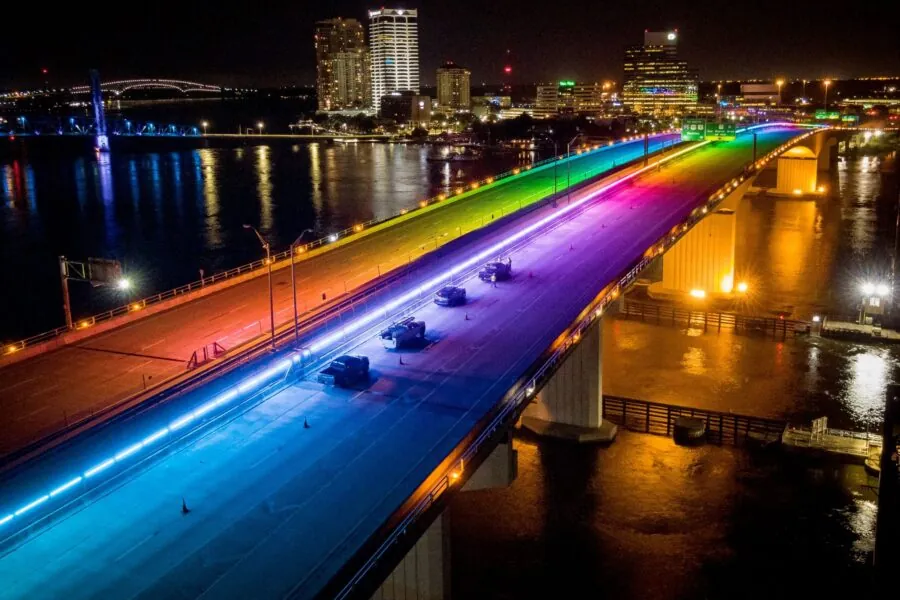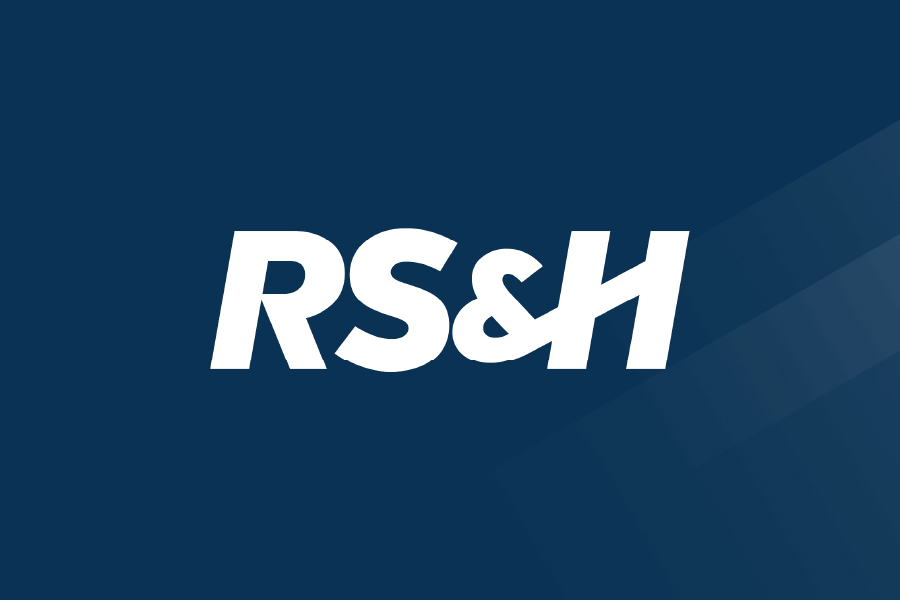Bridge LED Lighting Design Reduces Maintenance and Delights the Community

The Acosta Bridge over the St. Johns River in Jacksonville, Florida has long been a focal point on July 4. On Independence Day, the bridge has been the launch pad for the fireworks that light up Downtown and the city’s South Bank.
This year, the bright accents of red, white and blue again illuminated from the Acosta Bridge. But this new light show will remain long after the spent firework debris was cleaned up.
The Acosta now holds over 4,000 linear feet of color-changing, RGB, LED fixtures. Programmable by remote, the new lights can chase, flash, marquee, dim and twinkle in color schemes as diverse as a rainbow.
“Whatever your imagination can come up with is what we can program these lights to do,” said Jacksonville Transportation Authority (JTA) Design and Construction manager Todd Brearley.
The $2.4 million design-build project undertaken by Miller Electric, RS&H, ASI and Murphy Lighting Systems was completed a month early and under budget, giving ample time for JTA to prepare it for its Independence Day debut.
Video credit: Jacksonville Transportation Authority (JTA)
Worth the Wait
The new LED lighting design replaces a neon light system RS&H and Miller Electric designed in 1999. Visitors to the downtown Jacksonville Riverwalk could watch the long tubes of blue neon illuminating and chasing Jacksonville’s Skyway monorail back and forth across the bridge.
But as the system aged, maintenance costs grew as replacement parts became more and more scarce.
“We were having quite a few issues just maintaining the existing neon lights,” said JTA Assistant Vice President of Construction and Engineering Andrew Rodgers. “Oftentimes we would have a section go out, and it would be dark for months before we could get a replacement piece.”
The neon lights burned out for good in 2014. That’s when JTA began looking at what could replace the dilapidated system.
“As we started going through the process it went from replacing the neon to more and more scope,” said Shawn Fentress, principal for Architectural Sales & Illumination (ASI). “It turned into a full-fledged design job working with Miller Electric and RS&H. We really needed engineering drawings and documents to make sure we’re all on the same page.”
As the project grew in scope, technology gains in the lighting industry not only created more exciting replacement options, but more cost-effective options as well. By July 2019 when the contract was signed, color-changing LED lights proved to be the technology to use, but designing such a system still had its challenges.

Photo credit: RS&H
New Uses for Old Systems
The existing neon lighting system was fastened to steel cables on the bridge, which carries both vehicle and Skyway traffic. With renovations to the Skyway expected in the coming years to convert the monorail tub into an autonomous vehicle track, the project team strived to use as much existing infrastructure available for the new lights.
“We were not ready to remake the entire wheel just yet,” said RS&H Senior Electrical Engineer John Carew. “But a lot of the infrastructure that was in place, we were able to reuse effectively. We were able to reuse 99 percent of the existing conduit, as well as all the junction boxes.”
While much of the existing infrastructure could be reused, it required a lighting system of similar size and weight as the neon bulbs.
“We looked at a lot of lighting systems that had a low profile and low weight characteristic to it,” Carew said. “We had to factor in vibration, weather elements, the sun bearing down on it, constant exposure to humidity, salt from the river below and more.”
“As we were looking, the product from G&G Lighting was checking all the boxes.”
Based in New York, G&G LED Lighting specializes in making the waterproof, multicolor LED lights found in modern car washes. Their luminaires are linear LEDs with controllable RGB color mixing for fixed or dynamic effects. They are nearly cylindrical at 1.75 inches in diameter and daisy-chained for the long run lengths. Their weight at 2.25 pounds per linear foot is nearly identical to the original neon lighting. The lights provided a similar look as the original neon fixtures while providing significant advances in the illumination capabilities.
“This was a much more advanced option, but it was still a plug and play option,” said Joseph Mangels, a senior project associate for Miller Electric. “These lights could dim, fade, chase like a marquee, twinkle, strobe – there are so many possibilities for programming shows.”

Photo credit: Sue Root Barker for JTA
Opportunity for “Architainment”
The project team installed the lighting fixtures, as well as new decoders, power supplies and ballasts, fastening the fixtures to the existing bridge cables via 3D-printed clamps specifically designed for the system.
With the lights installed, the last challenge in place was how to control them.
“The lights are controlled in 24-foot sections, which sounds pretty long, but it looks pretty small when you’re a half-mile away,” Fentress said. “We had to figure out a way to access the programming remotely.”
Pathway Connectivity, the manufacturer of the control components, asked Orlando-based Murphy Lighting Systems to assist with the design of the control system and integrate it on site. The system can run events manually or as timed events, scheduled months or years ahead of time.
Murphy Lighting included a cellular connection and the services of SixEye, out of the United Kingdom, which offers a program that allows for control the lights remotely via cell phone, iPad or other device. Additionally, Murphy Lighting and ASI restored the neon system’s tracking feature, which uses a series of sensors and relays.
“It has been a lot of fun to see the reactions of those involved as the system came to life and they saw its full capabilities,” said Murphy Lighting Systems President Chris Murphy. “I think the residents of Jacksonville are going to be very impressed.”
“We were again able to reuse some of that original infrastructure, which is similar to the technology we’ve used on roller coaster projects in Orlando,” Fentress added. “When you had all these systems and features together, you really have the opportunity for “architainment” – architectural lighting used with entertainment in mind – that you see at theme parks.”
In addition to Independence Day, JTA officials expect to program the lights to celebrate several events in Jacksonville, including Jaguar games, Breast Cancer Awareness Month, the Florida-Georgia football game weekend, and more.
“The feedback we have received from the community has been very positive, and I think this project puts Jacksonville in a really nice spotlight,” Brearley said. “There are lot of exciting changes coming, and this might just be the tip of the iceberg.”
Looking back over the several years it took to secure funding for the Acosta Bridge project, Rodgers is thankful that the funding lined up with advances in technology to create something truly special.
“The vision for the project is several years in the making. The project team was spectacular. It’s been an exciting project that will provide a unique enhancement to the downtown skyline. I’m very thankful for the project team and I am happy to be a part of this project,” he said. “This is going to offer a lot of opportunities for the city.”
Top photo credit: Jacksonville Transportation Authority (JTA)




